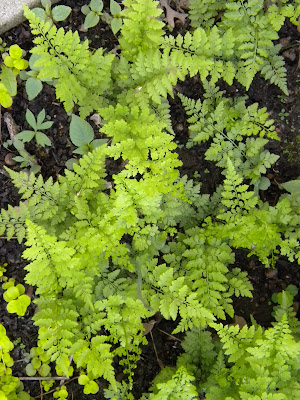Many of my favorite garden plants are those with interesting foliage. Relying on foliage for color and interest allows me to garden without too much concern for bloom times. That and I've always just liked neat-looking leaves.
Christmas Fern (Polystichum acrostichoides)
The first plants that come to mind when I think of foliage is ferns. I especially like the look of the ‘fiddleheads’ in the spring as they unfurl:
Mexican Male Fern (Dryopteris pseudo-filix-mas)
Some ferns are ephemeral: they die back to the ground at the onset of dry, hot weather. An example is the Fragile Fern, living at the edge of my chocolate garden. It’s a native fern, and it spreads somewhat quickly by underground rhizomes.
Fragile Fern (Cystopteris fragilis)
I really love the lacy look of maidenhair ferns. Another inhabitant of the chocolate garden is this ‘Miss Sharpless’ Northern Maidenhair, which has bronze new foliage and dark bronze wiry stems.
Adiantum pedatum 'Miss Sharpless', fronds almost unfurled.
But this isn't a post just about ferns! There are all sorts of interesting foliage plants in my garden.
Tiarella ‘Mint Chocolate’
Heuchera 'Blackcurrant'. I need to add some light green, fine foliage plants around this one to set off the color.
Persicaria ‘Lance Corporal’. I love the patterns on the leaves.
Heuchera ‘Brownies’ and ‘Caramel’. I planted them together on purpose, but for the names more than the look... mmm, caramel brownies....
Pulmonaria ‘Raspberry Splash’
Wild Sarsaparilla (Aralia nudicaulis) is a plant native to my yard.
You may notice from my pictures that I haven't gotten around to major weeding and mulching yet this year. Dandelions like to pop up everywhere, and grass seems to prefer growing in my garden beds over growing in the 'lawn'.
Yes, I do own a handful of Hosta. Here’s ‘June’, with some more grass.
Asarum aff. shuttleworthii
One of my favorite groups of plants is the Wild Gingers, or Asarum. I have many species in my garden, and I hope to collect more.
Asarum arifolium, or Little Brown Jugs, is named for its flowers which hide under the leaves. Also hiding beneath the leaves seem to be bits of cars(?) from the garage (my partner is a mechanic).
Silver is an excellent color for shade gardens, since it shines out against the gloom. So I'll end with a little bit of argent...
Some kind of Lungwort (Pulmonaria)
Another kind of Lungwort (also Pulmonaria). I really should try to figure out what their names are. I don't think I've ever bought a lungwort... they're all from friend's gardens.
Athyrium ‘Ghost’ …what? I didn’t promise I wouldn’t show another fern, did I?





















